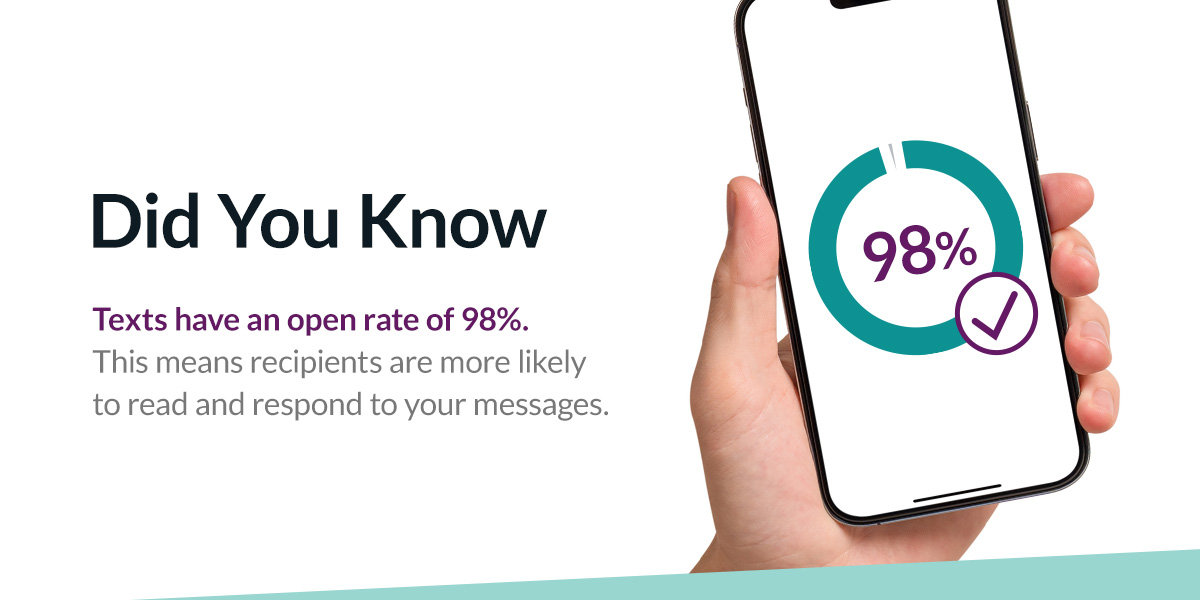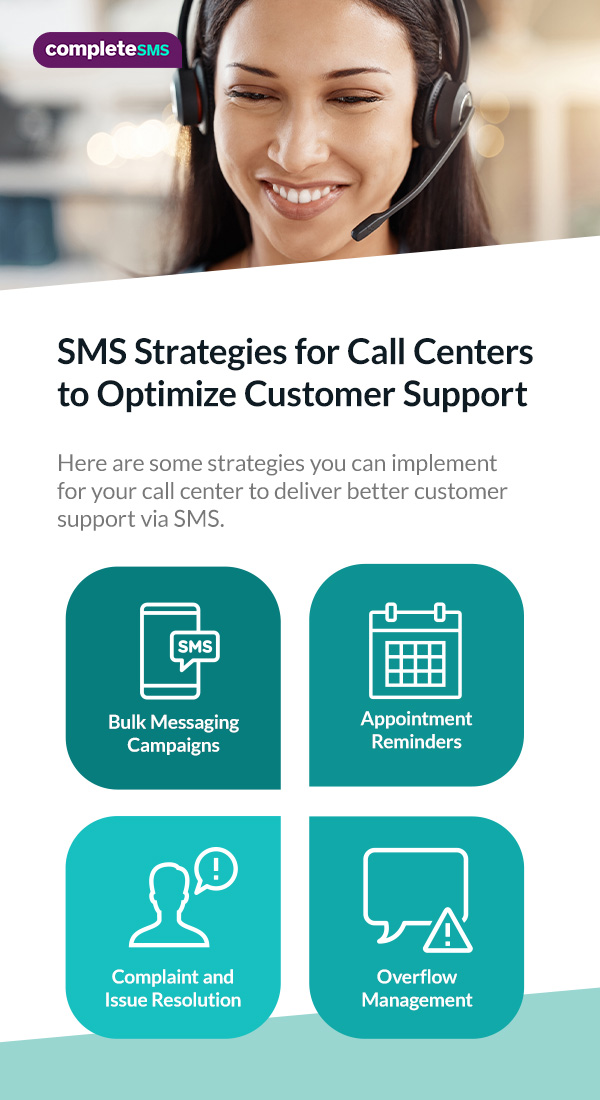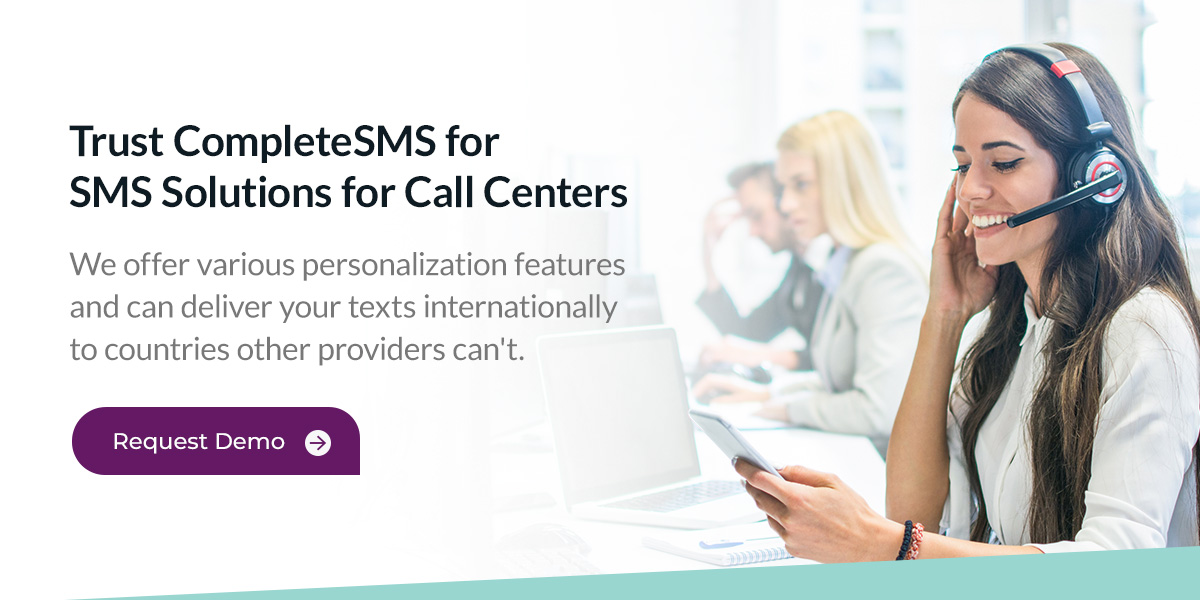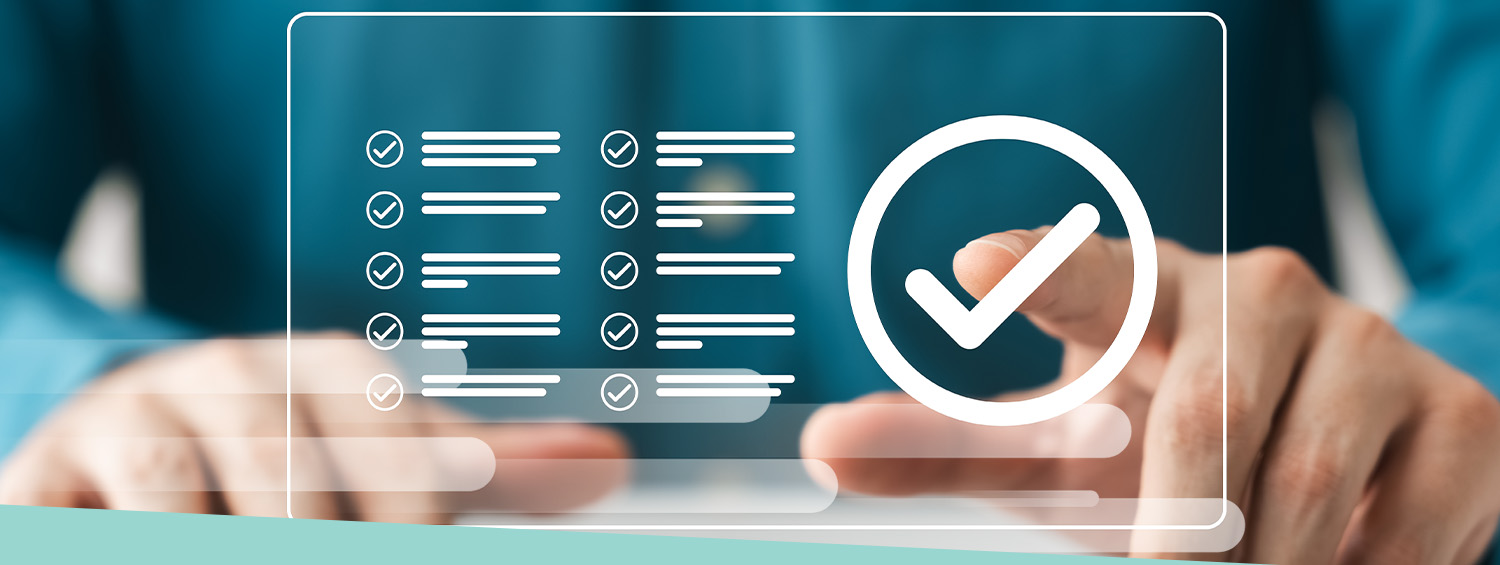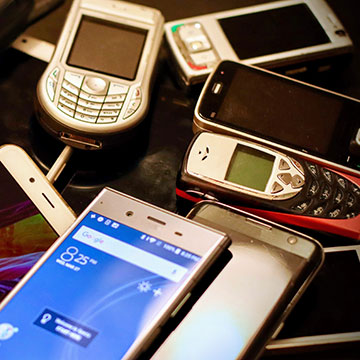
One of the biggest challenges call centers face is figuring out how to boost profits and keep overheads in check without letting customer service slip through the cracks. In most cases, callers have quick questions that need quick answers.
That’s where SMS comes in, a valuable channel to help you stay competitive. With this guide, you’ll learn how to use texts in your daily operations to better allocate resources like time and your agent’s efforts, ultimately improving customer satisfaction.
What Is Text Messaging for Call Centers?
Text messaging is a powerful tool call centers and contact centers can use to enhance customer service. As SMS is a convenient channel offering quick communication, it can complement or even entirely replace phone calls to answer questions and resolve simple support issues.
While texting for contact centers makes sense right off the bat, using such a channel at a call center might seem counterintuitive. However, embracing an omnichannel strategy can allow you to provide stellar support across various integrated channels. Beyond giving customers a choice of different channels to contact your business or department, integrating SMS can improve cornerstone metrics like your first contact resolution (FCR) rate.
It’s no secret that customers don’t enjoy getting the runaround. It’s frustrating having to repeat one’s issue, only to be placed on hold to wait for the next representative. In fact, customer satisfaction rates can drop by as much as 45% when their problem isn’t resolved at first contact. However, it’s tough to stay on top of customer calls when the amount of callers exceeds your agents, causing excessively long hold times.
Instead of leaving callers hanging, you can offer quick and effective service via SMS, optimizing call center operations. A higher FCR leads to happier customers and better retention rates. Plus, any sales agent will tell you how vital it is to nail your FCR rate—it’s what moves people through the customer journey to make a purchase.
What Are the Benefits of Using SMS for Call Centers?
Using SMS is beneficial for any business, including call centers, offering a more efficient way to communicate than traditional channels like phone calls and emails. Did you know that texts have an open rate of 98%? This means recipients are more likely to read and respond to your messages. There’s also an increasing preference for SMS among customers, especially Gen Z and millennials.
Let’s have a look at some more specific benefits of SMS for contact centers and call centers:
- Increase efficiency: Text message customer support is a great time saver, as you can use prewritten templates and set up automated responses. At a certain level agents could also handle more than one conversation at a time.
- Boost productivity: Without having to handle complaints and queries telephonically, customer care representatives will likely be more productive—especially with the automation capabilities SMS offers.
- Lower stress levels: Due to the nature of phone calls, call centers can be noisy environments. By using SMS to complement phone calls, you can create a much quieter and calmer workspace for your agents.
- Build on existing investments: Call centers and contact centers typically rely on a complex and costly infrastructure for their daily operations. Integrating SMS can help your business or department get the most out of its current set up.
Key Use Cases for SMS in Call Centers
Using SMS in call centers is better for all parties involved—customers, agents and the business itself. Here’s how you can use text messaging to provide customer service and support:
- Engage in two-way messaging: The two-way messaging capabilities of texting will make it much simpler for your team to deal with issues and queries as they pop up. Agents can even engage in multiple real-time SMS communications, dealing with several support tickets at once.
- Prevent customer holds: It’s impossible to help all customers as soon as they call. By implementing SMS, customers avoid wasting time being placed on hold. Instead, they can hang up and do something more productive while they wait for their call to be returned. You can send a text message to inform them of their place in line, offer estimated waiting times and call them back once it’s their turn.
- Set up automated responses: By giving customers the option to text your call center, you could eliminate the need for them to call in the first place. Once they send a text, they’ll trigger an automated response that lets them know you’ll call them when their turn comes. It’s also possible to set up automated messages to respond to FAQs. This way, when customers text in certain keywords, they instantly receive the relevant information or links to even more resources.
- Send follow-up texts: Following up is just as crucial as answering the call. If your agents can’t answer a caller’s question on the spot, they can send them a text with the information they need rather than putting them on hold. Another useful way to use SMS is to send callers a customer satisfaction survey after they’ve spoken to a representative.
- Transfer calls to SMS: If agents realize they can resolve a customer’s query or issue in a few back-and-forth texts, they can move the dialogue to an SMS thread. People prefer texting over calling because it’s a more convenient and less invasive method of communication. As a result, switching over from voice to text message customer service can improve caller satisfaction.
- Send updates: Sometimes, system failures and other technical hiccups happen, causing interruptions. You can rely on bulk SMS messaging to let all customers know about these temporary challenges and avoid an influx of frustrated callers. You can also send proactive updates about key changes, future events or any other relevant information—informed customers won’t feel the need to call.
SMS Strategies for Call Centers to Optimize Customer Support
With the above use cases in mind, here are some strategies you can implement for your call center to deliver better customer support via SMS.
Bulk Messaging Campaigns
Suppose you need to instantly contact a large number of customers, whether to share time-sensitive notifications or important information. In that case, a bulk SMS messaging campaign is ideal.
Be sure to time these messages wisely, being mindful of customers’ usage patterns and the best times for engagement. For example, recipients are much more likely to read a text sent at midday as opposed to one sent in the middle of the night or the early hours of the morning.
Appointment Reminders
Appointment reminders are one of the best ways for call centers in healthcare, travel, hospitality and various other industries to use SMS. By sharing the right information at the right time, you can reduce late arrivals and no-shows.
Rather than calling or emailing each client or customer individually, automated and prewritten texts will allow your team to save time and energy. Even though you’re using a template and are automating reminder messages, you can still include personalized details such as:
- The receiver’s booking date and time.
- The location of their appointment.
- Any preparation tips or instructions.
You should also schedule these reminder texts to be sent at specific intervals. For example, you can set up automated messages to go out a week before, then again the day before and even one last little reminder an hour before their appointment time.
Complaint and Issue Resolution
With an SMS integration, support tickets can be effortlessly created and managed within your business’s or department’s customer relationship management (CRM) system. As a result, it will be much easier to track and resolve customer issues.
Whether through an agent or automated message, you can send real-time updates to customers about the status of their issues or complaints. By giving them the information they need, you’ll likely cut down on follow-up calls.
If you want to streamline the issue resolution process even further while showing your customers that you care, send them a text to ask for feedback. Either include a link to an external survey or ask them a simple question that they can respond to directly via SMS.
Overflow Management
As mentioned, downtime is sometimes unavoidable. In the event that services are interrupted or other circumstances where your call center is experiencing higher demand than usual, informing customers with a text can help manage their expectations for agents’ response times.
You can also use SMS messages to provide customers with some alternative ways to reach out, like email or your business’s self-service portal. This way, they can still seek support even during an outage or moments of peak activity.
How Can Call Centers Start Using SMS?
If you want to start benefiting from SMS and implement the various uses and strategies to enhance the quality of customer service your call center delivers, follow these three steps.
1. Choose an SMS Platform
Application-to-person (A2P) messaging is best for business communications. Rather than texting customers from a personal number, which is known as person-to-person (P2P) messaging, A2P involves sending texts from a web-based platform or software program.
These solutions make it possible for you to automate texts after certain behaviors or triggers, which are essential for answering FAQs, providing support for issues, sending reminders and collecting feedback.
You’ll need to find a reputable A2P platform provider. Keep an eye out for the following:
- 24/7 support
- Turnkey or customizable solutions
- Global reach
- 10DLC compliance offerings
CompleteSMS offers SMS solutions for call centers. Whether you need to send bulk updates to a large number of recipients to engage in two-way conversations with individual customers to resolve complaints, we make it easy to send texts from a computer to any mobile device.
2. Integrate SMS With Your Existing Systems
With an SMS gateway application programming interface (API), you can use your call center’s exciting systems and databases to relay information through text messages. This means you can send vital information without having to switch platforms or applications.
Integrating SMS with your CRM system can help you store all customer interactions in one centralized location, optimizing workflows and making for a better customer experience. For call centers, such an integration ensures a seamless process—agents won’t need to confirm data or personalize the content of messages. Once set up, all data will be in one place, and you’ll be able to send SMS messages directly from your CRM software.
Additionally, integration with your automatic call distributor (ACD) will allow for a true omnichannel experience, such as making it possible for customers to reach out via text and then switch over to a phone call with the same agent. In periods of high demand with long waiting times, the ACD can also offer callers the choice to transfer to SMS.
To get the most out of SMS messaging, your provider should have robust third-party integration capabilities. At CompleteSMS, our SMS API for call centers allows compatibility with your business’s preferred software platform.
3. Set up Automated Workflows
Once you’ve chosen an A2P platform provider and integrated SMS with your call center’s key systems, you’re ready to start creating automated workflows for different scenarios. This simply means your A2P setup will automatically send texts after certain behaviors or actions.
For example, if a customer creates a support ticket, this action will trigger the SMS workflow to send an automated SMS with their ticket number and status. If an outage is detected, a proactive update will immediately be sent to all customers. For reminders, automated texts will be triggered by specific times and dates.
4. Follow Best Practices for SMS Messaging
Here are some best practices to help your call center maximize text messaging solutions:
- Stay compliant: Educate yourself on the various regulations you’ll need to comply with, such as the Spam Act of 2003 if you’re based in Australia and the Telephone Consumer Protection Act for businesses in the United States. Noncompliance can lead to mobile carriers flagging your texts as spam, meaning they won’t be delivered to recipients.
- Offer opt-in and opt-out instructions: Before texting customers, ensure you obtain their explicit consent—this is known as opting in. Beyond abiding by regulations, this can build trust. You should also offer instructions on how to opt out of receiving your call center’s texts.
- Send easy-to-read texts: Keep messages clear, concise and under 160 characters to avoid creating multiple messages. Readers should ideally be able to glance at your text and glean all the necessary information.
- Use personalization: Today, personalization is the expectation—76% of customers get frustrated when companies don’t deliver tailored interactions. Addressing recipients by name can go a long way.
- Use branded URLs: Including links can be a great way to share helpful tips with your customers or guide them to pages on your website where they can find the information they’re looking for. Just ensure you use the full URL or branded shortened URL.
SMS Templates for Call Centers
To help you save even more time and effort, use these templates for your call center’s automated messages and responses.
Customer Support Opt-In
Hi [Name], thanks for contacting our help desk! Just a heads up that we offer text-based customer service. If you want to chat with one of our representatives via text, reply YES to this message. If you’d prefer for our next available representative to call you, reply NO.
Wait Time Alert
Hi [Name], our customer care representatives are busy at the moment. The wait time is currently [X] minutes. How can we assist? Reply to this message with a summary of your issue.
Customer Satisfaction Survey
Hi [Name], how was your latest conversation with our customer care representative? Please rate your experience on a scale of 1 (poor) to 5 (excellent).
Support Ticket Update
Hi [Name], your support ticket #[Ticket Number] is being reviewed. We’ll get back to you within 24 hours.
Appointment Reminder
Hi [Name], just a friendly reminder that you have an appointment with [Company] on [Date] at [Time]! Please reply with CONFIRM to let us know you’ll be there, or call us to reschedule.
Outage Notification
Hey [Name], we wanted to let you know about a service interruption in your area on [Date] from [Time]. We’re sorry about any inconvenience this may cause! We’re working hard to get things back up and running – [Company Name].
Operation Hours
Thank you for contacting our help desk! All customer care representatives are currently unavailable. Call back Monday to Friday between 8 a.m. and 5 p.m. To get help right now, reply to this text for SMS support.
Trust CompleteSMS for SMS Solutions for Call Centers
Texting can make it much easier for call centers and contact centers to provide convenient and quick communication that fulfills the needs of customers. However, integrating the right SMS tools and platforms is vital for enhancing operational efficiency and customer service.
If you want to unlock the full potential of this channel, CompleteSMS has a range of solutions. We offer various personalization features and can deliver your texts internationally to countries other providers can’t. With us, you’ll also get 24/7 support and assistance with 10DLC registration to help you stay compliant.
To experience the power of SMS for yourself, request a demo today!


